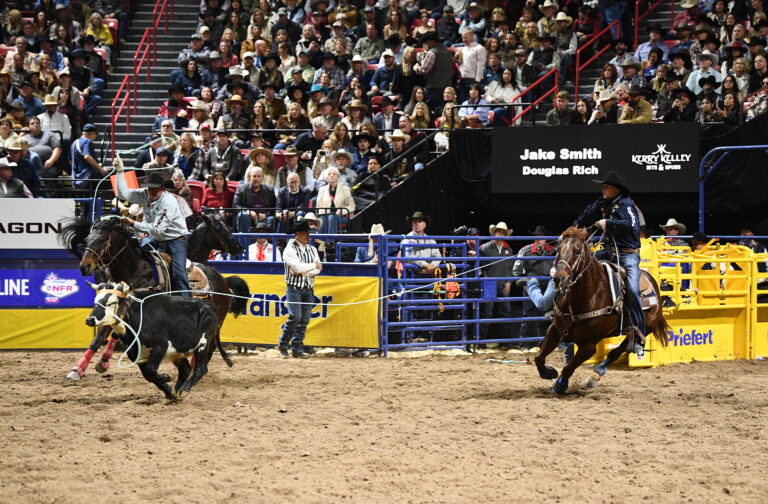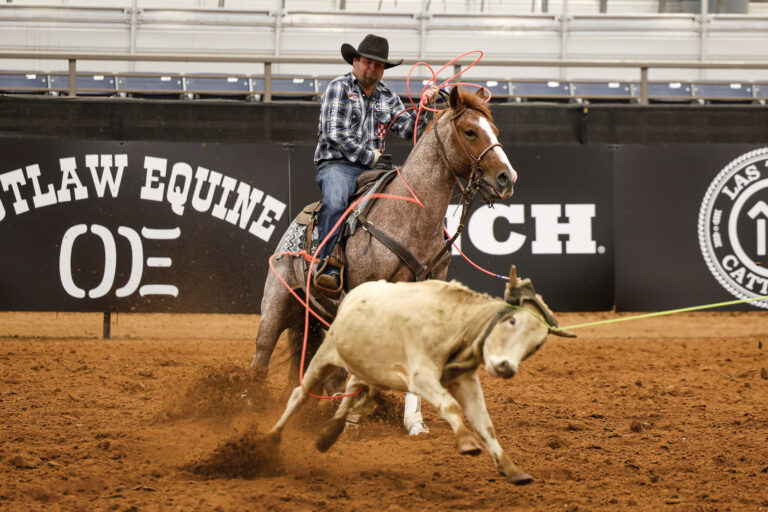Neither Wood I and Ryan Motes weathered the storm of the hard-running, fresh cattle at the Texas Best Rope Horse Derby April 14, netting owner Kerry Kelly $7,220 for a score of 926.32 on four head.
Motes credits the help of his former NFR partner Brock Hanson for much of the win, with Hanson’s head horse making the hard-hitting steers user friendly for Motes and his gritty-tough Dual Rey-bred colt.

“It was full contact,” Motes, 42 admitted. “The arena wasn’t too long, and the steers weren’t wanting to leave, but when they did, they were full contact on the end of it when they got out there. It made the good horses really shine. They had 48 or 49 in the heading and only 15 catch two. It was really, really tough. Those steers were strong. So that was a good spot for that horse’s ability. He’s really gritty, really tough. The first steer he was awesome on. They’re big, and they hit them hard. He hit one harder after the first round, and I had to put more rubber on my horn after the third run. That last steer, he handled really big and fought his head, and Brock got him around the neck, and this horse nearly burned the rubber off my horn he hit so hard. He kept hitting them harder and harder all day long.”
“This horse nearly burned the rubber off my horn he hit so hard. He kept hitting them harder and harder all day long.”
— Ryan Motes on Dual-Rey gelding Neither Wood I
Home-Raised
Motes’ family—which includes brother-in-law and Hall of Fame cutter R.L. Chartier—has long been connected to Neither Wood I. The horse’s dam, Wood I Never, was a great show horse for Chartier, and she’s now one of the family ranch’s broodmares.
“R.L. had that horse as a colt for sale as a 2-year-old,” Motes explained. “He wasn’t quite making a cutter, so R.L. sold him to Dylan Dyson—a neighbor kid who rides all our 2-year-olds. And then last fall, right before the ARHFA, Dylan and his wife were getting ready to have a baby so he was wanting to sell him. He mentioned it, and I said I’d like to find somewhere good for him to go.”
Motes ropes with bitmaker and neighbor Kerry Kelly nearly every day when he’s not rodeoing. Kelly was at Motes’ outdoor arena one day when Motes was riding the then 4-year-old last fall to try to find a new owner for the talented colt, and he noticed him.
“He said, ‘That’s a good horse,’ and I said, ‘I agree,'” Motes said. “He asked me why I didn’t buy him, and I said, ‘By the time I get him finished, I’ll be finished also.’ He said, ‘Why don’t I buy him and have you finish him and show him for me?'”
So that’s what they did. He didn’t go to the ARHFA World Championship in October, but when Tate Kirchenschlager needed a run at the Riata Buckle, Motes and Neither Wood I stepped up and the talented young horse hung with the pack.

Turn-Back Style
Some Dual Rey horses have gotten a tough-minded rap in team roping circles, but Motes and his crew have a knack for managing them.
“R.L.’s had really really good luck with Dual Rey,” Motes explained. “They have a reputation of being tough. He didn’t have enough cow for R.L., but Dylan spent two years turning back on him. The arena stuff comes easy for him because of all the hours Dylan spent in the saddle on him. Too often, you get a horse, whether they’ve been in a cutting program or reining program, they have them in a stall, catch them out of a stall, saddle, lope and put them back in the stall. That time riding as a turnback horse Dylan put on him, with a Dual Rey that’s a little tougher as a 3-year-old, made him not really want to work as a cutter. The extra time spent in the arena, with Dylan just riding him and doing everything on him, forcing him into a job. He’d turn back on him, gather cattle, check cattle, be saddled all morning, and actually learn what a job was, instead of just going from the stall to training—that all matters. A lot of times the ones that are good turnback horses are a little tougher. It’s long days, and they’ve been through all of that.” TRJ









